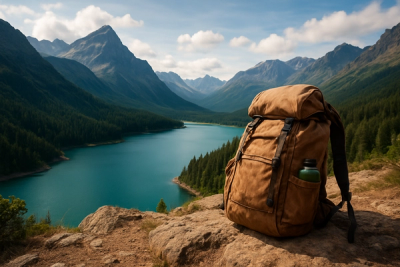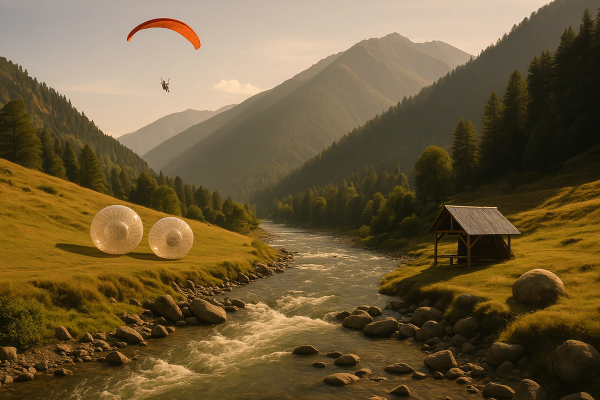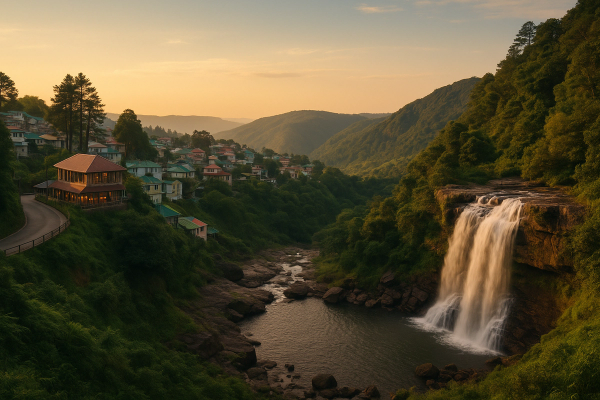Munnar Monsoon Guide: Tea Gardens, Trails & Mist — from a soaked, happy desi traveler#
I went to Munnar in peak rains because, honestly, I’m a little mad like that. Everyone was like bro, you’ll get stuck, roads close, clouds will eat your view, what is the point. But yaar, when that mist wraps around the hills and the tea leaves look like someone polished each one with coconut oil, it’s a whole different mood. Not touristy-perfect. Real. Wet sneakers, cardamom smell, chechi handing me hot chai even though my clothes were dripping on her floor. I’ve done the winter-views scene before, all clear sky and postcard angles. Monsoon Munnar is messier, more intimate. The kind where you end up talking to a tea worker under a tin roof while lightning grumbles somewhere over Devikulam, and you’re both smiling for no reason.¶
Why the monsoon is the best time to feel Munnar (and also slightly argue with it)#
June to September is the Southwest monsoon in Kerala, then a lighter round in October–November. Strong rains, dramatic clouds, waterfalls going full beast mode. Fewer crowds, lower hotel rates compared to Dec–March. On the flip side, visibility swings — one minute turquoise hills, next minute whiteout. Trails can get slippery, leeches love you like you’re their long-lost cousin. If you’re the type who wants guaranteed sunrise at 5:58 am, monsoon will troll you. But if you like moody landscapes, tea-scented air, and those sudden breaks of sun where the valleys glow neon green — basicly, if you want Munnar to feel alive — rains are perfect. And you get to see locals doing life in the fog: buses crawling, school kids in plastic ponchos, tea pluckers laughing like the weather is just another colleague.¶
Getting there & real-time travel updates (don’t skip this in rains)#
Kochi to Munnar by road is roughly 4–5 hours if the weather behaves. The usual route is via NH 85 — Aluva, Kothamangalam/Neriamangalam, Adimali — then up the curves to Munnar. IMD issues Orange/Red alerts quite often in heavy spells, and Idukki district (where Munnar sits) has, in recent seasons, seen landslides around Kallar and stretches after Adimali. I kinda learnt the hard way: start early, keep buffer time, and call your stay the evening before to confirm access. KSRTC buses run from Ernakulam and Aluva; they’re reliable, cheap (usually under ₹200–₹350), and in rough weather they feel safer than small cars. A one-way cab is ₹4,000–₹6,500 depending on vehicle and bargaining. As of 2025, the drill is the same: check Kerala State Disaster Management Authority (KSDMA) updates, IMD nowcasts, and local WhatsApp groups your homestay host will add you to — they share “road open/closed” like breaking news. Worst case, detour via Kattappana/Devikulam or wait it out in Adimali eating hot pazham pori.¶
Tea gardens & the Tea Museum — more than wallpaper, trust me#
Walk anywhere near Pothamedu, Chithirapuram, Pallivasal, Lockhart Gap, and you’ll see tea slopes criss-crossed with stone paths. I thought it’s fine to just stroll inside. Nope. Estates are working farms — politely ask your host or a local guide to point safe public paths. I chatted with a plucker chechi who told me how they shift schedules in heavy rain, tea leaves actually look happier after a proper shower. KDHP Tea Museum (Nallathanni Estate) is the nerdy part of the trip I didn’t expect to enjoy so much. Timings usually 9:00 am to 5:00 pm, closed Mondays. Tickets hover around ₹150–₹200 for adults, camera charges extra, UPI accepted. There’s a small demo on processing and a tasting that’s not fancy but solid — you’ll smell the difference between orthodox and CTC. Rainy-season tip: go early to avoid the bus groups, and carry a light jacket; the museum isn’t cold, but the exit to outside hits you with a mist slap.¶
Trails & treks that make sense in the rain (not all, but these do)#
- Letchmi Hills: A gentler hike with sweeping tea views and shola patches. In mist, it’s dreamy — the kind of place where even bad photos look poetic.
- Pothamedu–Attukad area: Not a single designated trail, more a mix of estate paths and viewpoints. Rains turn Attukad into a roaring beauty. Stay on known tracks, don’t be hero.
- Chokramudi Peak (with a licensed guide): Only if rainfall is moderate. The ascent gets slippery, but mist swirling around the ridge is basically movie-level feels.
- Marayoor side detour & Chinnar Wildlife Sanctuary boardwalks: Rain-shadow zone beyond Munnar — if Munnar is pouring, Marayoor/Chinnar can be surprisingly dry. Dolmens at Muniyara feel ancient in gloomy weather.
Permits matter — some routes need forest permissions, always go with a registered guide for anything beyond the easy estate edges. Costs vary a lot: group treks ₹1,000–₹2,500 per person depending on distance and whether transport/snacks included. Leeches… ya they’ll attend like uninvited relatives. Wear leech socks or tuck pants into thick socks, dab Dettol on shoes, carry salt or a dab of sanitizer. Good grip shoes, a rain jacket that actually keeps water out (not the flimsy one you buy at a bus stop), and a dry bag for phone. If thunder starts rumbling, don’t hang around ridgelines showing bravery to Instagram. Come down, sip chai, live to trek another day.¶
Waterfalls & lakes — rain makes them wild and wow#
Attukad Waterfalls near Pullupara looks delicate in summer; in monsoon it’s like a fast-forwarded version. There’s a small viewpoint area and sometimes makeshift tea stalls — heavy rain can close access, so just don’t argue with the guards. Lakkam Waterfalls (toward Marayoor) is my favourite because the plunge pool feels like a secret courtyard if water is not crazy. Forest staff may restrict entry to the pool during high flow. Mattupetty Dam: boating usually 9 am–5 pm, but if the rain gets too intense they pause. Kundala Lake has pedal boats and that serene vibe where clouds kiss the water and vanish — wear life jackets even if you’re a pro swimmer, and avoid the temptation of “let’s go nearer to the middle” in strong wind. Echo Point, honestly, is hit-or-miss in rains. But when mist clears, the reflections on the reservoir — uff, pure desktop wallpaper material.¶
Eravikulam National Park — seeing the Tahr in the mist#
Rajamalai (Eravikulam) runs a shuttle-bus system from the base to the viewing area. Online booking is standard now — slots can sell out on weekends even in monsoon, which surprised me. The park usually closes in Feb–Mar for Nilgiri Tahr’s calving season, so plan around that. In the rains, trails inside are limited but the bus ride itself, climbing into the cloud, gah… it’s beautiful. You might get only glimpses of the Tahr grazing on wet grass, so carry binoculars if you geek out on wildlife. Ticket prices are around a couple hundred for Indians, more for foreign nationals, and they include the bus. Don’t wander off. The slopes are steep and slippery, and staff will whistle you back quick. Wear a cap — drizzle plus wind in your face is a recipe for weird hair in all your photos.¶
Kolukkumalai & Top Station — sunrise memes vs actual reality#
Everyone talks about Kolukkumalai sunrise like it’s some guaranteed spiritual awakening. It can be. Or it can be a white screen with you and six strangers clutching paper cups of tea at 5 am wondering what is life. Jeeps from Suryanelli (border area near Theni district side) charge roughly ₹5,000–₹7,000 per jeep — per person rates are usually ₹1,500–₹3,000 depending on group size. The road is a bumpy adventure in itself, rain makes it not dangerous per se but definitely spicy. In very heavy spells, estate/forest officials sometimes restrict timings, so book with reputable operators who’ll be honest about the weather call. My hack: even if sunrise is a bust, do a late-morning visit — you get the tea-factory tour feel, and clouds sometimes part in dramatic patches. Top Station viewpoint is similar, moody. When it clears, you see deep valleys into Tamil Nadu like layers of green origami.¶
Where to stay & what it costs (monsoon edition)#
Staying in-town is convenient if you’re bus-ing, but for the full green overdose, pick hill-facing areas like Chithirapuram, Pallivasal, Pothamedu, Bison Valley, Suryanelli. Budget homestays: ₹1,500–₹3,000 per night with breakfast, sometimes less on weekdays. Mid-range resorts: ₹3,500–₹8,000 — many throw in plantation walks, bonfires (if rain chills), and tea tasting. Luxury stays: ₹10k–₹25k+ when they’re not doing monsoon promos, and yes the views can be insane even if cloud plays hide-n-seek. I stayed at a homestay run by a super warm chechi who would basically force me to eat more puttu after every hike — spotty Wi-Fi but unfussy rooms and a balcony where mist walked in like a guest. Ask about backup power (rains trip lines), late check-in during downpours, and whether their access road is properly metalled. Flexi cancellation is your friend in this season.¶
Food you shouldn’t skip — rain is hunger’s best friend#
Appam with veg stew on a grey morning is just… perfect. Puttu–kadala is the monsoon champion. Parotta–beef pepper fry at a local hotel (Kerala does beef, don’t @ me) hits a different level after you’ve been rained on for hours. Kerala fish curry with red rice is comfort-food royalty. There’s a Sulaimani tea culture — black tea with lime, a gentle pick-me-up. Cardamom tea is everywhere, obvs. In town, Rapsy Restaurant is famous, expect crowds, biriyani’s solid and the lemon tea is nice. Veg joints (Saravana Bhavan style, several clones) are reliable for dosas and meals. At roadside thattukadas, I found annoyingly good pazham pori and hot tea for ₹20, and the guy refused to take extra. Typical meal cost in Munnar: ₹120–₹300 for basic plates, ₹350–₹600 for meat/fish mains at mid-tier places. Rain tip: carry tissues, eat indoors if thunder starts, and don’t leave food out — hill ants move like they have Wi-Fi.¶
Safety, packing & monsoon hacks — no drama, just common sense#
Pack a decent poncho or rain jacket (hood that actually stays), waterproof shoes or sandals with grip, quick-dry clothes, a compact umbrella for the city bits, leech socks if you’re trekking, salt or sanitizer for de-leeching, power bank, headlamp, and an extra phone ziplock. Download offline maps — Jio/Airtel work but mist pockets do weird things to signal. Cash plus UPI — most places accept UPI now, but the card machine can sleep in rain. Keep one buffer day in your plan; don’t be that person shouting at nature on checkout day. If you’re self-driving, honk before curves, keep headlights on in fog, and follow bus drivers — they’re wise to slippery patches. Wild elephants are not jokes; if locals say wait, you wait. If IMD drops a Red alert, pause the trek. And always tell your host where you’re heading; WhatsApp live location is not overkill out here.¶
Why go in monsoon again? Because it’s not only “pretty” — it’s alive#
I keep hearing people say, rains will ruin your trip, better come in winter. Bro, winter is great for views, agreed. But the monsoon story is different — kids playing cricket in fog, chai smoke mixing with the smell of wet earth, waterfalls booming like speakers, tea leaves shining, locals moving around like this weather is just their everyday. Resorts are offering tea tasting workshops and small estate walks more frequently nowadays, even during rains, and rates are kinder. You can actually sit and listen. Also, fewer cars means you can take that long curve, stop, and feel the mist on your face without someone honking. It’s quieter. More patient. More Kerala, in a way.¶
Quick rain-aware checklist for must-do places#
Tea Museum — open Tue–Sun, mornings are best. Eravikulam — check online bookings and closures (Feb–Mar likely closed), carry jacket. Attukad, Lakkam — flow depends on rainfall, obey guards. Mattupetty/Kundala boating — life jackets, paused in heavy rain. Kolukkumalai — jeep cost varies, whiteout risk is real, choose operators who respect weather calls. Trails — pick Letchmi/Pothamedu on heavy-rain days, save Chokramudi for a calmer window. Marayoor/Chinnar — good Plan B if Munnar is soaking; dolmens at Muniyara, sandalwood forest zones need respect and no littering, please. And wherever you go — assume cloud will change the scene in 5 minutes. That’s half the fun.¶
Local vibes & practicals you’ll actually use#
Language-wise, English is fine, Hindi also works most places, but a little Malayalam smile goes a long way: “chettan” for elder brother, “chechi” for elder sister. Tipping isn’t mandatory but appreciated for guides and drivers on tough-weather days. Drones are restricted near parks/forests — don’t fly. Plastic bottles… sigh — bring your own refillable. Small bakeries do great tea-time snacks in the evenings; ask for banana chips or halwa if you want proper Kerala sugar rush. Bus conductors will tell you honestly if a road’s messy — I got more accurate intel from them than Google. And if someone says wait half an hour for clouds to lift, don’t roll your eyes. I did, twice, then got a view that made me shut up real fast.¶
Current safety scene (because yes, rains are unpredictable)#
Recent monsoons across Kerala have brought Orange/Red alerts multiple times, especially in Idukki’s hill stretches. Landslides are not constant but do happen — KSDMA pushes timely alerts on social and the district admin coordinates closures. Many resorts now share real-time updates on WhatsApp, which is wild but super helpful. Boating operations and certain viewpoints close fast if the rain crosses the safe mark; it’s not drama, it’s protocol. Buy basic travel insurance if you’re planning jeep trips and treks — it’s cheap peace of mind. If you’re the planner type, book stays with flexible policies, and keep one alternate day activity (Tea Museum, cafes, short estate walks) when clouds decide they’re the boss.¶
So… was it worth getting drenched? My short answer: absolutely#
I had days of full mist where even my own shoes looked hazy. I had evenings with golden sunshine blasting through clouds for 10 minutes like some movie director pressed play. I had silly fights with leeches, and then laughed about it over parotta and tea with strangers who became friends for that night. Rains didn’t ruin it; they gave it texture. Munnar in monsoon isn’t neat. It’s not fuss-free. But it felt honest, like you’re being let in on a quieter everyday that tourists don’t often see.¶
If you’re planning now, here’s my personal route suggestion#
Day 1: Kochi to Munnar via Adimali — tea museum and slow walk in Pothamedu by evening. Day 2: Letchmi Hills morning trek, late lunch and Attukad viewpoint; keep room for cloud surprises. Day 3: Eravikulam early slot, Sulaimani in town, loaf around markets for spices and a rain-binge meal. Day 4: If weather allows, Kolukkumalai sunrise or late-morning visit, then Kundala boating on the way back. Keep Marayoor/Chinnar as your Plan B if Munnar’s pouring — dolmens and lighter showers will still scratch the wander itch. And leave one flex day. Don’t rush; it’s a hill station not a checklist race.¶
Money stuff (very quick, promise)#
Bus tickets ₹150–₹350 depending on route, cabs ₹4k–₹6.5k one-way Kochi–Munnar, homestays from ₹1.5k, mid-range ₹3.5k–₹8k, luxe ₹10k–₹25k+. Jeep to Kolukkumalai ₹1.5k–₹3k per person or ₹5k–₹7k per jeep, park/museum tickets in the couple-hundred range. Meals ₹120–₹600 depending where you eat. UPI works almost everywhere, carry ₹1k–₹2k cash just in case. Prices move with season and weekend demand — don’t @ me if your resort has a flash sale or a surge, that’s how hill stations roll.¶
The small things that made it special for me#
A bus conductor chettan who slowed at a bend and said, “See? Now valley.” And right on cue, clouds lifted for 5 seconds and we all gasped like kids. A homestay dog who escorted me to the gate in rain like I was some VIP. Chai stalls where you recieve your cup with both hands like a ritual. Roadside jackfruit chips shared with a stranger who insisted I take more because I’m from the other side of the state. These tiny kindnesses are Munnar’s secret sauce. You don’t need perfect weather for them.¶
Final thoughts — tea, mist, and that quiet happiness#
If you want clarity, go winter. If you want feeling, go monsoon. Munnar in the rains won’t always show you its face — but when it does, it’s pure magic. Pack smart, listen to locals, respect alerts, and give yourself time to sit — sip tea, watch clouds build and break. Travel isn’t only the postcard, na. It’s the moments. If you liked this mix of story plus actual info, check out AllBlogs.in — I keep finding good, grounded travel reads there whenever I’m plotting my next rainy escape.¶














